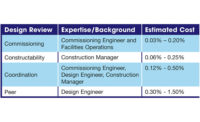After working with the building owner to develop the owner’s project requirements (OPR) document for a project, one of the first activities for a commissioning professional is conducting third-party reviews of the design team’s work. Commissioning design reviews focus on, but are not limited to, compliance with the OPR, design clarity, accessibility and maintainability, O&M training and documentation requirements, and the ability to test and validate system operation.
Commissioning professionals document their comments in a format intended to be easy and practical for the design team to manage. Historically, the most common format has been a table with a comment or question on each row and a column for the design team’s responses. The use of online databases for documenting, responding to, and tracking comments is becoming more common. Web-based, collaborative design document development and review platforms are also popular, especially for large projects. In the latter, everyone on the project team, including the commissioning professional, inserts comments directly into the drawings and specifications.
Regardless of the format in which these comments are documented, the design team must respond to each of them during the commissioning process. This is not a trivial task. It requires a meaningful time commitment, usually when the design team is under deadline to progress forward with their design.
We see a wide range of engagement by design teams across our commissioning projects. Sometimes the design team is effectively non-responsive, regardless of how many reminders they’re given. In those cases, we have documentation of all of the commissioning review comments but no answers to questions or commitments to modify (or not) the design in future packages.
As we review subsequent design submissions, we can backcheck each of our comments to determine if the design team clarified or changed anything with respect to our issues. If there is a change that appears to meet the OPR criteria, we can close out our previous comment by noting the design modification in the commissioning documentation. However, if there is no change and the initial concern remains, we do not know whether that is because the design team did not read our comment or they read it and decided it had no merit. Such issues need to remain open until the design team’s intent is clear.
We in the commissioning community believe the time and effort spent responding to commissioning comments is not only beneficial to the project and the owner but also the design team. Respectfully submitted comments can help designers avoid future rework and change orders or, worse, end-of-construction, design-related performance issues. Next month’s column will explore options for improving the commissioning design review process.





